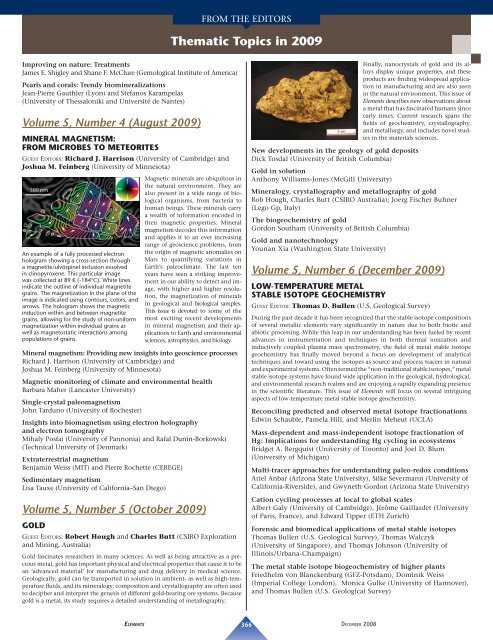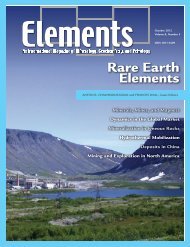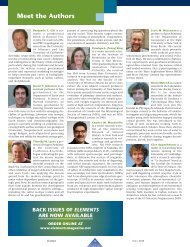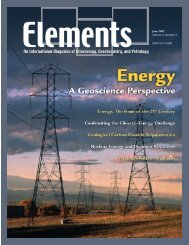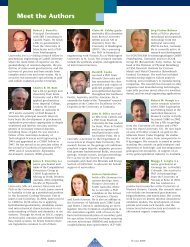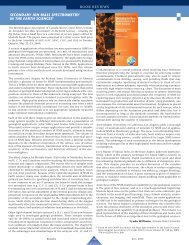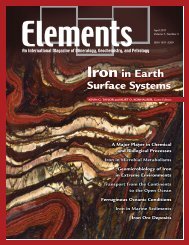Nanogeoscience - Elements
Nanogeoscience - Elements
Nanogeoscience - Elements
You also want an ePaper? Increase the reach of your titles
YUMPU automatically turns print PDFs into web optimized ePapers that Google loves.
Improving on nature: Treatments<br />
James E. Shigley and Shane F. McClure (Gemological Institute of America)<br />
Pearls and corals: Trendy biomineralizations<br />
Jean-Pierre Gauthier (Lyon) and Stefanos Karampelas<br />
(University of Thessaloniki and Université de Nantes)<br />
Volume 5, Number 4 (August 2009)<br />
MINERAL MAGNETISM:<br />
FROM MICROBES TO METEORITES<br />
GUEST EDITORS: Richard J. Harrison (University of Cambridge) and<br />
Joshua M. Feinberg (University of Minnesota)<br />
An example of a fully processed electron<br />
hologram showing a cross-section through<br />
a magnetite/ulvöspinel inclusion exsolved<br />
in clinopyroxene. This particular image<br />
was collected at 89 K (-184°C). White lines<br />
indicate the outline of individual magnetite<br />
grains. The magnetization in the plane of the<br />
image is indicated using contours, colors, and<br />
arrows. The hologram shows the magnetic<br />
induction within and between magnetite<br />
grains, allowing for the study of non-uniform<br />
magnetization within individual grains as<br />
well as magnetostatic interactions among<br />
populations of grains.<br />
Magnetic minerals are ubiquitous in<br />
the natural environment. They are<br />
also present in a wide range of biological<br />
organisms, from bacteria to<br />
human beings. These minerals carry<br />
a wealth of information encoded in<br />
their magnetic properties. Mineral<br />
magnetism decodes this information<br />
and applies it to an ever increasing<br />
range of geoscience problems, from<br />
the origin of magnetic anomalies on<br />
Mars to quantifying variations in<br />
Earth’s paleoclimate. The last ten<br />
years have seen a striking improvement<br />
in our ability to detect and image,<br />
with higher and higher resolution,<br />
the magnetization of minerals<br />
in geological and biological samples.<br />
This issue is devoted to some of the<br />
most exciting recent developments<br />
in mineral magnetism and their applications<br />
to Earth and environmental<br />
sciences, astrophysics, and biology.<br />
Mineral magnetism: Providing new insights into geoscience processes<br />
Richard J. Harrison (University of Cambridge) and<br />
Joshua M. Feinberg (University of Minnesota)<br />
Magnetic monitoring of climate and environmental health<br />
Barbara Maher (Lancaster University)<br />
Single-crystal paleomagnetism<br />
John Tarduno (University of Rochester)<br />
Insights into biomagnetism using electron holography<br />
and electron tomography<br />
Mihaly Posfai (University of Pannonia) and Rafal Dunin-Borkowski<br />
(Technical University of Denmark)<br />
Extraterrestrial magnetism<br />
Benjamin Weiss (MIT) and Pierre Rochette (CEREGE)<br />
Sedimentary magnetism<br />
Lisa Tauxe (University of California–San Diego)<br />
Volume 5, Number 5 (October 2009)<br />
GOLD<br />
GUEST EDITORS: Robert Hough and Charles Butt (CSIRO Exploration<br />
and Mining, Australia)<br />
Gold fascinates researchers in many sciences. As well as being attractive as a precious<br />
metal, gold has important physical and electrical properties that cause it to be<br />
an ’advanced material’ for manufacturing and drug delivery in medical science.<br />
Geologically, gold can be transported in solution in ambient- as well as high-temperature<br />
fl uids, and its mineralogy, composition and crystallography are often used<br />
to decipher and interpret the genesis of different gold-bearing ore systems. Because<br />
gold is a metal, its study requires a detailed understanding of metallography.<br />
FROM THE EDITORS<br />
Thematic Topics in 2009<br />
Finally, nano crystals of gold and its alloys<br />
display unique properties, and these<br />
products are fi nding widespread application<br />
in manufacturing and are also seen<br />
in the natural environment. This issue of<br />
<strong>Elements</strong> describes new observations about<br />
a metal that has fascinated humans since<br />
early times. Current research spans the<br />
fi elds of geochemistry, crystallography,<br />
and metallurgy, and includes novel studies<br />
in the materials sciences.<br />
New developments in the geology of gold deposits<br />
Dick Tosdal (University of British Columbia)<br />
Gold in solution<br />
Anthony Williams-Jones (McGill University)<br />
Mineralogy, crystallography and metallography of gold<br />
Rob Hough, Charles Butt (CSIRO Australia); Joerg Fischer Buhner<br />
(Lego Gp, Italy)<br />
The biogeochemistry of gold<br />
Gordon Southam (University of British Columbia)<br />
Gold and nanotechnology<br />
Younan Xia (Washington State University)<br />
Volume 5, Number 6 (December 2009)<br />
LOW-TEMPERATURE METAL<br />
STABLE ISOTOPE GEOCHEMISTRY<br />
GUEST EDITOR: Thomas D. Bullen (U.S. Geological Survey)<br />
During the past decade it has been recognized that the stable isotope compositions<br />
of several metallic elements vary signifi cantly in nature due to both biotic and<br />
abiotic processing. While this leap in our understanding has been fueled by recent<br />
advances in instrumentation and techniques in both thermal ionization and<br />
inductively coupled plasma mass spectrometry, the fi eld of metal stable isotope<br />
geochemistry has fi nally moved beyond a focus on development of analytical<br />
techniques and toward using the isotopes as source and process tracers in natural<br />
and experimental systems. Often termed the “non-traditional stable isotopes,” metal<br />
stable isotope systems have found wide application in the geological, hydrological,<br />
and environmental research realms and are enjoying a rapidly expanding presence<br />
in the scientifi c literature. This issue of <strong>Elements</strong> will focus on several intriguing<br />
aspects of low-temperature metal stable isotope geochemistry.<br />
Reconciling predicted and observed metal isotope fractionations<br />
Edwin Schauble, Pamela Hill, and Merlin Meheut (UCLA)<br />
Mass-dependent and mass-independent isotope fractionation of<br />
Hg: Implications for understanding Hg cycling in ecosystems<br />
Bridget A. Bergquist (University of Toronto) and Joel D. Blum<br />
(University of Michigan)<br />
Multi-tracer approaches for understanding paleo-redox conditions<br />
Ariel Anbar (Arizona State University), Silke Severmann (University of<br />
California-Riverside), and Gwyneth Gordon (Arizona State University)<br />
Cation cycling processes at local to global scales<br />
Albert Galy (University of Cambridge), Jérôme Gaillardet (University<br />
of Paris, France), and Edward Tipper (ETH Zurich)<br />
Forensic and biomedical applications of metal stable isotopes<br />
Thomas Bullen (U.S. Geological Survey), Thomas Walczyk<br />
(University of Singapore), and Thomas Johnson (University of<br />
Illinois/Urbana-Champaign)<br />
The metal stable isotope biogeochemistry of higher plants<br />
Friedhelm von Blanckenburg (GFZ-Potsdam), Dominik Weiss<br />
(Imperial College London), Monica Gulke (University of Hannover),<br />
and Thomas Bullen (U.S. Geological Survey)<br />
ELEMENTS 366<br />
DECEMBER 2008


